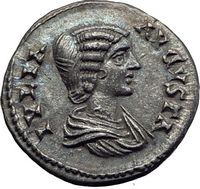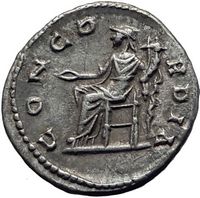Julia Domna - Roman Empress Wife of Emperor Septimius Severus 193-211 A.D. -
Silver Denarius 17mm (3.14 grams) Laodicea ad Mare mint 196-202 A.D.
Reference:
RIC 637 (Septimius Severus), S 6577
IVLIA AVGVSTA - Draped bust right.
CONCORDIA - Concordia seated left, holding patera and cornucopia. You are bidding on the exact item pictured, provided with a Certificate of Authenticity and Lifetime Guarantee of Authenticity.
In ancient Roman religion, Concordia is the goddess who embodies
agreement in marriage and society. Her Greek equivalent is usually regarded
as Harmonia, with musical harmony a metaphor for an ideal of social concord
or entente in the political discourse of the Republican era. She was
thus often associated with Pax ("Peace") in representing a stable society.
As such, she is more closely related to the Greek concept of homonoia
(likemindedness), which was also represented by a goddess.
Concordia Augusta was cultivated in the context of Imperial cult.
Dedicatory inscriptions to her, on behalf of emperors and members of the
imperial family, were common.
In art
In art, Concordia was depicted sitting, wearing a long cloak and holding
onto a patera (sacrificial bowl), a cornucopia (symbol of prosperity), or a
caduceus (symbol of peace). She was often shown in between two other
figures, such as standing between two members of the Imperial family shaking
hands. She was associated with a pair of female deities, such as Pax and
Salus, or Securitas and Fortuna. Paired "Security and Luck" could also be
represented by Hercules and Mercury.
Temples
The oldest Temple of Concord, built in 367 BC by Marcus Furius Camillus,
stood on the Roman Forum. Other temples and shrines in Rome dedicated to
Concordia were largely geographically related to the main temple, and
included (in date order):
- a bronze shrine (aedicula) of Concord erected by the aedile Gnaeus
Flavius in 304 BC "in Graecostasis" and "in area Volcani" (placing it on
the Graecostasis, close to the main temple of Concord). He vowed it in
the hope of reconciling the nobility who had been outraged by his
publication of the calendar, but the senate would vote no money for its
construction and this thus had to be financed out of the fines of
condemned usurers. It must have been destroyed when the main temple was
enlarged by Opimius in 121 BC.
- one built on the arx (probably on the east side, overlooked the main
temple of Concord below). It was probably vowed by the praetor Lucius
Manlius in 218 BC after quelling a mutiny among his troops in Cisalpine
Gaul, with building work commencing in 217 and dedication occurring on 5
February 216.
- a temple to Concordia Nova, marking the end Julius Caesar had
brought to civil war. It was voted by the senate in 44 BC. but was
possibly never built.
- a temple built by Livia according to Ovid's Fasti VI.637‑638 ("te
quoque magnifica, Concordia, dedicat aede Livia quam caro praestitit
ipsa viro" - the only literary reference to this temple). The
description of the Porticus Liviae follows immediately, and it is
probable therefore that the temple was close to or within the porticus,
but the small rectangular structure marked on the Marble Plan (frg. 10)
can hardly have been a temple deserving of the epithet "magnifica" (HJ
316).
In Pompeii, the high priestess Eumachia dedicated a building to Concordia
Augusta.
Modern religion
Harmonians and some Discordians equate Concordia with Aneris. Her
opposite is thus Discordia, or the Greek Eris.
| Wife of Septimius Severus | Mother of Caracalla and Geta | Sister of Julia Maesa | Aunt of Julia Soaemias and Julia Mamaea | Great-aunt of Elagabalus and Severus Alexander | Mother-in-law of Plautilla | Julia Domna, (Latin: Iulia Domna; c. 170 AD - 217 AD) was a member of the Severan dynasty of the Roman Empire. Empress and wife of Roman Emperor Lucius Septimius Severus and mother of Emperors Geta and Caracalla, Julia was famous for her prodigious learning as well as her extraordinary political influence. Family backgroundJulia Domna was born in Emesa (known today as Homs) in Syria. She was the youngest daughter of the high-priest of Ba'al Gaius Julius Bassianus and sister to Julia Maesa, and she had two nieces: Julia Mamaea, mother of Severus Alexander, and Julia Soaemias, mother of Elagabalus. Her ancestors were Priest Kings of the famous temple of Elagabalus. The family had enormous wealth and was promoted to Roman senatorial aristocracy. Before her marriage, Julia inherited the estate of her paternal great-uncle Julius Agrippa, a former leading Centurion. ReignIn the late 180s, Julia married future emperor Septimius Severus, usually considered to be of Punic background. They had two sons, Lucius Septimius Bassianus (Caracalla) in 188 and Publius Septimius Geta in 189. Because of her love of philosophy, Julia protected philosophers and helped philosophy to flourish in Rome. She was an imperial woman from 193-217 CE as wife to the emperor Septimius Severus and mother to emperors Geta (murdered by Caracalla in 211 CE) and Caracalla (r. 211-217 CE). Julia Domna died shortly after her son Caracalla was murdered. Civil War or "Year of the Five Emperors"After Commodus was murdered without an heir in 192 CE, many contenders rushed for the throne. An elder senator, Pertinax, was appointed by the praetorian guard. When Pertinax would not meet the guard's demands of payment, his son-in-law Iulianus was called to Rome. After bribing the guard, Iulianus was appointed emperor, and Pertinax was murdered. Septimius Severus, coming from the north into Rome, overthrew Iulianus and had him executed. Septimius claimed the title of emperor in 193, and co-ruled Rome with Clodius Albinus until 195 CE when Septimius declared his sons AVGVSTVS, and defeated Albinus and his British legions. Septimius remained at war with an eastern rival to the throne, Niger, until he defeated Niger's forces in 201 CE. Julia Domna and her sons accompanied Septimius in his campaigns in the East. During this time, titles were granted to Julia Domna reminiscent of titles given to Faustina the Younger, including MATER CASTORVM, or mother of the camp, MATER AVGVSTVS, mother of Augustus, and MATER PATRIAE, or mother of the fatherland. Imperial Building Project: The aedes VestaeThe fire of Commodus in 192 CE destroyed areas of the aedes Vestae which includes the Temple of Vesta and the home, or Atrium, of the Vestal Virgins. Based on numismatic evidence, historical authors, and a laconic inscription found in situ, most scholars agree that Julia Domna funded restorations to the site during Septimius Severus's reign. Controversy and transition of powerAs empress, Julia was often involved in intrigues and had plenty of political enemies, who accused her of treason and adultery. None of these accusations was proven. Severus continued to favour his wife and insisted on her company in the campaign against the Britons that started in 208. When Severus died in 211 in Eboracum (York), Julia became the mediator between their two sons, Caracalla and Geta, who were to rule as joint emperors, according to their father's wishes expressed in his will. The two young men were never fond of each other and quarrelled frequently. Geta was murdered by Caracalla's soldiers in the same year. Caracalla was now sole emperor, but his relations with his mother were difficult, as attested by several sources, probably because of his involvement in Geta's murder. Nevertheless, Julia accompanied Caracalla in his campaign against the Parthian empire in 217. During this trip, Caracalla was assassinated and succeeded (briefly) by Macrinus. Julia chose to commit suicide after hearing about the rebellion, perhaps a decision hastened by the fact that she was suffering from breast cancer. Her body was brought to Rome and placed in the Sepulcrum C. et L. Caesaris (perhaps a separate chamber in the Mausoleum of Augustus). Later, however, both her bones and those of Geta were transferred by her sister Julia Maesa to the Mausoleum of Hadrian. She was later deified. ApolloniusIf it were not for Julia, there would have survived little information about the philosopher Apollonius of Tyana. It was at the behest of Julia that Philostratus wrote his now famous Life of Apollonius of Tyana. Julia is thought to have died before Philostratus could finish his work of eight volumes.
|




